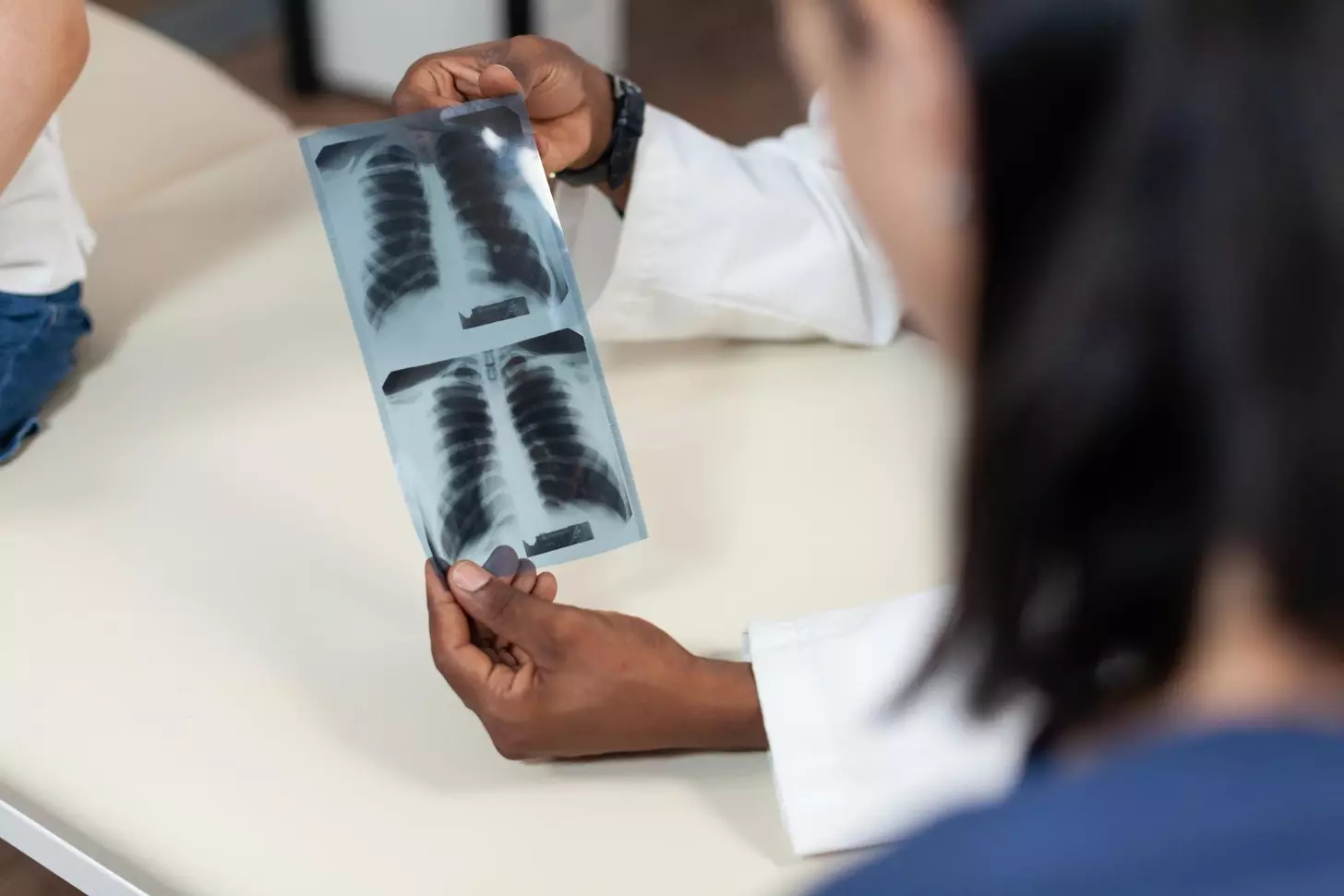Last Updated on November 27, 2025 by Bilal Hasdemir

At Liv Hospital, we know how vital it is to be informed about squamous cell carcinoma of the lung. This is a common type of lung cancer. It’s linked to smoking and often found in the central airways.
We’ll cover the key facts about this condition. You’ll learn about its causes, symptoms, how it’s diagnosed, and treatment options. Knowing these facts helps both patients and healthcare providers manage and treat it well.
We’ll share insights from a patient-focused view. This way, you’ll have the info you need to understand this complex condition.
Key Takeaways
- Squamous cell carcinoma is a type of non-small cell lung cancer.
- It is strongly associated with smoking.
- Early detection is key for effective treatment.
- Treatment options depend on the stage and overall health.
- Knowing the causes and symptoms is essential for diagnosis.
What Is Squamous Cell Carcinoma of the Lung?
Squamous cell carcinoma of the lung is a big part of non-small cell lung cancer. It has its own set of challenges in finding and treating it. Knowing about this condition is key to giving good care.
Definition and Classification
Squamous cell carcinoma of the lung starts in the squamous cells. These are flat cells that line the airways in the lungs. It’s a type of non-small cell lung cancer.
This cancer mainly grows in the center of the airways. It’s often linked to smoking.
Classification of squamous cell carcinoma looks at the tumor’s microscopic details. It checks for keratinization or intercellular bridges. These are signs of squamous differentiation.
Prevalence and Demographics
Squamous cell carcinoma makes up about 25-30% of lung cancers. It’s a big part of non-small cell lung cancer. The amount of this cancer varies in different groups of people.
| Demographic Factor | Prevalence Characteristic |
|---|---|
| Age | More common in older adults, typically diagnosed between the ages of 65 and 75. |
| Gender | Historically more prevalent in men, but the incidence in women is increasing, likely due to changes in smoking patterns. |
| Smoking History | Strongly associated with a history of smoking, with the majority of patients having been smokers. |
Knowing these details is important for catching squamous cell carcinoma of the lung early. It helps in managing it better.
Causes and Risk Factors
It’s important to know what causes squamous cell carcinoma of the lung. This knowledge helps in preventing and catching it early. We’ll look at the main factors that lead to this disease.
Smoking and Tobacco Use
Smoking and using tobacco are big risks for squamous cell carcinoma of the lung. Studies show a strong link between smoking and this lung cancer type. Lung cancer often comes from long-term tobacco smoke exposure. This smoke has many harmful chemicals that harm lung cells.
Tobacco smoke has many harmful chemicals that can cause cancer. The more you smoke, the higher your risk of getting squamous cell carcinoma of the lung. Quitting smoking is key to lowering this risk.
Other Environmental Risk Factors
Other than smoking, some environmental and work hazards can also raise lung cancer risk. These include:
- Radon gas, a known carcinogen that can build up in homes and workplaces.
- Asbestos exposure, mainly in work settings.
- Other harmful substances like arsenic, chromium, and nickel.
These substances can harm lungs and raise cancer risk, more so for smokers.
Genetic Predisposition
Genetics also play a part in squamous cell carcinoma of the lung. People with a family history of lung cancer might be at higher risk. Some genetic changes can affect how the body handles harmful substances and repairs DNA, raising cancer risk.
Genetic predisposition can’t be changed, but knowing about it helps in understanding risk. It guides decisions on screening and prevention.
Common Symptoms and Warning Signs
Knowing the signs of squamous cell carcinoma of the lung is key. We’ll cover the main symptoms and signs to watch for.
Respiratory Symptoms
Respiratory symptoms often show up first. Look out for a persistent cough, chest pain, and shortness of breath. If you cough up blood or rust-colored sputum, get help right away.
Systemic Symptoms
Systemic symptoms can also happen. You might notice unexplained weight loss, fatigue, and loss of appetite. These signs can mean the disease is getting worse.
When to See a Doctor
If you have any of these symptoms, see a doctor. Early treatment can make a big difference. Don’t wait if symptoms get worse or last too long.
Diagnosis and Staging of Squamous Cell Carcinoma of the Lung
Healthcare providers use many tests to find and stage squamous cell carcinoma of the lung. Accurate diagnosis is key for the right treatment and better patient results.
Diagnostic Procedures
Several tests help diagnose squamous cell carcinoma of the lung. These include:
- Imaging Tests: Chest X-rays, CT scans, and PET scans show the tumor’s location and size.
- Biopsy: A biopsy takes tissue from the tumor for microscopic examination.
- Bronchoscopy: This lets doctors see the airways and take tissue samples.
Understanding the Staging System
The staging system for squamous cell carcinoma of the lung shows how far the disease has spread. The TNM system is commonly used. It looks at:
- Tumor Size and Extent (T): The tumor’s size and if it has invaded nearby tissues.
- Lymph Node Involvement (N): If the cancer has spread to nearby lymph nodes.
- Metastasis (M): If the cancer has spread to other parts of the body.
Importance of Early Detection
Finding squamous cell carcinoma of the lung early is vital for better treatment results. Early detection means a higher chance of successful treatment. Regular check-ups and screenings are important for those at high risk of lung cancer.
Understanding diagnosis and staging helps patients make informed decisions about their care.
How Squamous Cell Lung Cancer Differs from Other Lung Cancers
Squamous cell lung cancer is a type of non-small cell lung cancer. It has unique features that make it different from other lung cancers. Knowing these differences helps doctors create better treatment plans for each type of lung cancer.
Comparison with Small Cell Lung Cancer
Non-small cell lung cancer (NSCLC) includes squamous cell carcinoma. It’s different from small cell lung cancer (SCLC). SCLC grows fast, spreads early, and is very aggressive. Squamous cell lung cancer grows slower and spreads later than SCLC.
Here’s a table showing the main differences between these two lung cancers:
| Characteristics | Squamous Cell Lung Cancer | Small Cell Lung Cancer |
|---|---|---|
| Growth Rate | Generally slower | Rapid |
| Metastasis | Later stage | Early stage |
| Treatment Approach | Surgery, targeted therapy | Chemotherapy, radiation |
Differences from Other Non-Small Cell Lung Cancers
Squamous cell lung cancer is also different from other NSCLC types like adenocarcinoma and large cell carcinoma. These differences are important for treatment and how well a patient might do.
Key differences include:
- Histological Features: Squamous cell carcinoma has keratinization and intercellular bridges. These are not seen in other NSCLC types.
- Molecular Profiles: Squamous cell carcinoma has different genetic changes than adenocarcinoma.
Implications for Treatment and Prognosis
The differences between squamous cell lung cancer and other lung cancers affect treatment and how well a patient might do. Knowing these differences helps doctors create more personalized and effective treatments.
For example, squamous cell lung cancer might be treated with surgery and targeted therapy. SCLC often needs chemotherapy and radiation. The outlook also varies, with squamous cell lung cancer usually having a better chance of survival when caught early.
We stress the importance of accurate diagnosis and staging. This helps doctors find the best treatment for patients with squamous cell lung cancer.
Treatment Options for Squamous Cell Carcinoma of the Lung
Treating squamous cell carcinoma of the lung involves different methods. These include surgery and targeted therapies. The right treatment depends on the cancer’s stage, the patient’s health, and other factors.
Surgical Interventions
Surgery is key for early-stage lung cancer. Surgical resection aims to remove the tumor and affected lymph nodes. We look at several surgical options:
- Lobectomy: Removing the lobe with the tumor
- Pneumonectomy: Taking out the whole lung if needed
- Wedge resection or segmentectomy: Taking out the tumor with some healthy tissue
Each surgery has its own benefits and risks. We talk to patients about these to find the best option.
Radiation Therapy
Radiation therapy is also important for lung cancer. It can be used alone or with surgery or chemotherapy. External beam radiation therapy uses beams from outside the body to target cancer cells.
Stereotactic body radiation therapy (SBRT) is also used. It gives precise, high doses of radiation to the tumor, protecting healthy tissue.
Chemotherapy Protocols
Chemotherapy uses drugs to kill cancer cells. For lung cancer, it may be used before or after surgery. This helps shrink tumors or get rid of remaining cancer cells.
We use different chemotherapy protocols. These often combine drugs to work better. The choice depends on the cancer’s stage, the patient’s health, and other factors.
Targeted Therapies and Immunotherapy
Targeted therapies and immunotherapy are new ways to treat lung cancer. Targeted therapies target specific cancer traits. Immunotherapy boosts the body’s immune response against cancer.
We consider these treatments for advanced disease or when other therapies fail. Examples include checkpoint inhibitors and other immunotherapies.
By mixing these treatments, we create a plan that fits each patient’s needs.
Metastasis Patterns and Disease Progression
Squamous cell carcinoma of the lung can spread to different parts of the body. It’s important to know how it spreads to manage and treat the disease effectively.
Common Sites of Metastasis
This type of lung cancer often goes to the liver, bones, brain, and adrenal glands. We’ll look at how often it happens and what it means for patients.
| Site of Metastasis | Frequency | Clinical Implications |
|---|---|---|
| Liver | Common | Affects liver function, potentially leading to jaundice and altered metabolism |
| Bones | Frequent | Can cause bone pain, fractures, and hypercalcemia |
| Brain | Less Common | May result in neurological symptoms, seizures, and increased intracranial pressure |
| Adrenal Glands | Less Frequent | Can lead to adrenal insufficiency and hormonal imbalances |
Monitoring Disease Progression
It’s key to watch how squamous cell carcinoma of the lung progresses. We use imaging and biomarkers to track it.
For more on lung cancer spread, visit LivHospital. They have detailed info on lung cancer metastasis.
Understanding metastasis patterns helps us tailor treatments for each patient. This way, we can improve their outcomes.
Prevention and Risk Reduction Strategies
To prevent squamous cell carcinoma of the lung, we must tackle its main risk factors. We will look at ways to lower the risk of getting this disease.
Smoking Cessation Programs
Smoking is the top cause of squamous cell carcinoma of the lung. So, smoking cessation is key. Support, counseling, and nicotine replacement therapy can help people quit.
Environmental and Occupational Safety
Exposure to things like asbestos, radon, and chemicals also raises the risk. Making workplaces safer can help reduce these risks.
| Prevention Strategy | Description | Effectiveness |
|---|---|---|
| Smoking Cessation Programs | Programs with counseling and nicotine replacement therapy | High |
| Environmental Controls | Steps to cut down on carcinogen exposure like asbestos and radon | Moderate to High |
| Occupational Safety Regulations | Rules for safe work environments | High |
Using these prevention and risk reduction strategies can greatly lower lung cancer cases.
Conclusion: Living with Squamous Cell Carcinoma of the Lung
Living with squamous cell carcinoma of the lung needs a full approach. This includes medical treatment, supportive care, and lifestyle changes. We’ve covered the disease’s causes, symptoms, diagnosis, treatment options, and prevention strategies.
Effective lung cancer management comes from a team of experts. They help patients and their families deal with the disease. It’s key to understand the disease and its effects. This way, patients and their families can face the challenges better.
Managing squamous cell carcinoma of the lung is complex. It depends on the disease stage, overall health, and personal choices. We urge patients to work with their healthcare providers. Together, they can create a treatment plan that meets the patient’s specific needs.
FAQ
What is squamous cell carcinoma of the lung?
Squamous cell carcinoma of the lung is a type of lung cancer. It starts in the squamous cells. These cells line the airways in the lungs.
What are the primary risk factors for developing squamous cell carcinoma of the lung?
Main risk factors include smoking and tobacco use. Exposure to certain hazards and genetics also play a role.
What are the common symptoms of squamous cell carcinoma of the lung?
Symptoms include a persistent cough and chest pain. Shortness of breath, unexplained weight loss, and fatigue are also common.
How is squamous cell carcinoma of the lung diagnosed?
Diagnosing involves imaging tests and biopsies. These confirm cancer and its stage.
What are the treatment options for squamous cell carcinoma of the lung?
Treatments include surgery, radiation, and chemotherapy. Targeted and immunotherapy options also exist, based on cancer stage and patient health.
Can squamous cell carcinoma of the lung be prevented?
While prevention is not always possible, reducing risk factors helps. This includes quitting smoking and avoiding environmental hazards.
How does squamous cell carcinoma of the lung differ from other types of lung cancer?
It differs in histological characteristics and treatment implications. This makes it unique among lung cancer types.
What are the common sites of metastasis for squamous cell carcinoma of the lung?
It can spread to the liver, bones, brain, and adrenal glands.
Why is early detection of squamous cell carcinoma of the lung important?
Early detection improves outcomes. It allows for timely treatment and intervention.
What is the role of a multidisciplinary care team in managing squamous cell carcinoma of the lung?
A multidisciplinary team provides essential care. They offer medical treatment, supportive care, and lifestyle advice.
Is squamous cell carcinoma of the lung considered non-small cell lung cancer?
Yes, it is classified as non-small cell lung cancer.
Reference
Lung Cancer Foundation of America (LCFA). Squamous Cell Carcinomas. https://lcfamerica.org/about-lung-cancer/diagnosis/types/squamous-cell-carcinomas/
NCBI. Research. https://www.ncbi.nlm.nih.gov/books/NBK564510/








